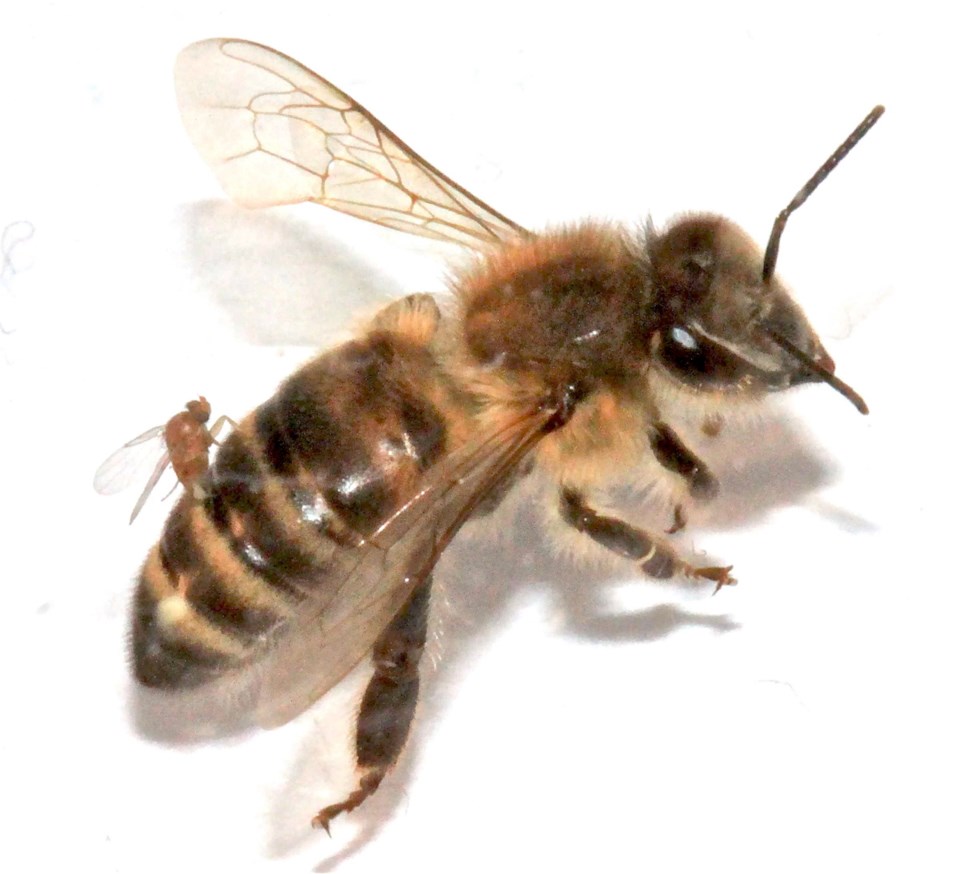Canada’s first case of a “zombie bees” — a deadly new honeybee affliction — has been documented in Lantzville, near Nanaimo.
Sarah Wallbank had been beekeeping for only three months when she noticed some of her bees appearing disoriented last month. They were flying frantically into a light at night, when honeybees typically don’t fly, then acting stupefied in the morning, she said.
An online search led her to ZomBeeWatch.org, a citizen-science project documenting the spread of a fatal parasite. Wallbank collected the bees using a light trap and submitted photos. An expert confirmed the case.
John Hafernik, a biology professor at San Francisco State University who runs the site, first identified zombie bees, or “zombees,” in 2008.
“They’re called zombie bees because they show really strange, disoriented behaviour,” he said.
The bees are infected by the parasite apocephalus borealis, or “zombie flies,” which are native to North America. The fly lands on the honeybee’s abdomen and uses a hypodermic needle-like appendage to inject it with eggs. Parasites grow inside the bee in the form of fly larvae or maggots that feed on the bee’s muscles.
After a few days, the bee abandons its hive at night and dies. A week later, maggots erupt from bee’s head and thorax.
“It’s a little bit like Alien, except it’s real,” Hafernik said.
About a month after that, parasitic flies emerge.
Zombie flies are widely distributed across North America, as far north as Alaska, but they typically affect bumblebees and wasps.
Hafernik first identified the problem in honeybees after he found some stranded under a lamp post on campus.
“Initially I didn’t think much of it; I was feeding them to a praying mantis,” he said.
But one day he forgot a vial on his desk and came back to find them filled with pupae — insects between the larval and adult forms that look like flaxseed.
He published his findings in 2012 and launched the website ZomBeeWatch.org in an effort to document the phenomenon.
“We knew the fly was widely distributed across North America. The question we had was: Is it doing this to honeybees everywhere, or just a few places?”
Almost 3,000 citizen scientists have reported possible sightings of parasitized bees through the site, from Vermont to Virginia.
Early zombee sightings were mostly limited to the U.S. West Coast and South Dakota, but the Canadian discovery adds to mounting evidence that the phenomenon is spreading across North America.
Infection rates are expected to rise during the summer and peak in fall.
Unless a bee dies and releases pupae in the hive, it’s not a condition that would spread from bee to bee.
“We think it’s primarily happening when bees are foraging for pollen and nectar,” Hafernik said.
There is no way of killing the flies without endangering honeybees with pesticides, Hafernik said. The best preventive technique is keeping a healthy hive.
Zombie flies are just one threat to honeybees in North America. Lloyd Erickson, treasurer of the Nanaimo Bee Club, said the biggest is varroa mites, which appeared about 30 years ago. They mites are themselves harmful but also carry viruses.
“It’s very contagious, and transfers from bee colony to colony very quickly,” Erickson said.
“Some beekeepers have experienced catastrophic losses some years, but not everyone is hit at the same time.”
View Royal bee master Barry Denluck, of Barry’s Bees, said a fungal parasite called nosema ceranae is the second major threat. It attacks the bee’s intestines, making the bee a burden to the rest of the colony and threatening its ability to produce enough honey.
Hot and dry weather also means less nectar production and fewer food sources for honeybees.
Combined, it means beekeeping has become significantly more difficult in the past 20 years.
“Beekeeping has really changed. When I started, I just picked up some bees, plunked them down, watched them for a few months and then I had honey. That doesn’t happen anymore. Now you have to be diligent in your management protocol, otherwise you’re going to fail,” he said.
Other threats include pesticides and viral and fungal diseases.
Denluck, who keeps bees at sites across Greater Victoria, said he was unaware of other zombie-bee behaviour, although bees can act abnormally for many reasons.
According to San Francisco State University, zombee research could contribute to an understanding of “colony collapse disorder.” One symptom of the disorder is abandoning hives, which has been largely unexplained.
Back in Lantzville, Wallbank — who is chef and general manager of a small bakery and restaurant called Riso that uses local ingredients — plans to continue beekeeping. Her hive is a healthy 30,000 and still growing.
She continues to collect about eight to 20 zombees each night as part of her pest management program.
“This morning, I only collected two. Maybe my setting this trap is affecting the flies,” she said. “But I’m anticipating it will be an ongoing thing while I’m keeping bees.”
She said she hopes her story encourages others to send samples to the project and help honeybees by planting bee-friendly plants.



